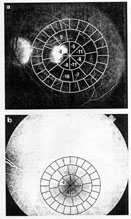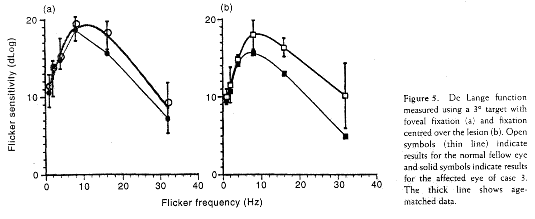
Localized scotomata detected with temporal modulation perimetry in central serous chorioretinopathy
Aim: Flicker deficits have been reported in various maculopathies, including age-related macular degeneration. We test whether flicker losses exist in patients with central serous chorioretinopathy (CSC) and whether the size and flicker frequency of the target is important in detecting such losses.
Methods: We examined four CSC patients with temporal modulation (flicker perception) perimetry using the Medmont auto-flicker module (Medmont Pty Ltd, Melbourne, Vic. Australia), as well as static perimetry and colour vision. One case was examined using sophisticated laboratory equipment to precisely measure their temporal contrast sensitivity function (temporal CSF or de Lange curve) using larger targets to consider the effect of target frequency and size. Two patients were followed longitudinally and tested after resolution of the maculopathy. We compared our patients with an age-matched control group of 11 people.
Results: Temporal modulation perimetry detected larger and more localized defects in all cases of active CSC compared with static perimetry. There appeared to be size and frequency tuning to the deficit, with greatest loss being found at 16 Hz with small (0.5°) targets. The losses resolved in one case where the retina recovered in 4 weeks, but remained to a lesser degree in another case who suffered a 2 year long fluctuating course before the CSC subsided.

Conclusions: Temporal modulation perimetry detects a loss of flicker sensitivity in patients with CSC. Deeper and more clearly defined scotomata are found with a flickering stimulus compared with a steady state one. The greatest losses of flicker sensitivity are found with 16 Hz modulation and with small targets located directly over the lesion. The duration of the disease may be important for recovery of flicker sensitivity. Temporal modulation perimetry appears to be a valuable tool for the confirmation of functional loss due to CSC.
Published in full in:
Australian and New Zealand Journal of Ophthalmology 1999; 27: 109-116
Algis J Vingrys¹, BscOptom, PhD and Konrad Pesudovs² and BscOptom, FAAO
¹ Visual Functions Laboratory, Department of Optometry and Vision Sciences,
The University of Melbourne, Parkville, Victoria and
² Department of Ophthalmology, Flinders Medical Centre and Flinders University of
South Australia, Australia
Key words: central serous chorioretinopathy, flicker perimetry, maculopathy, temporal modulation perimetry.
![]() ANZJO CSC as PDF (130 Kb)
ANZJO CSC as PDF (130 Kb)
![]()
Index of Papers
[ Welcome ][ Publications ]